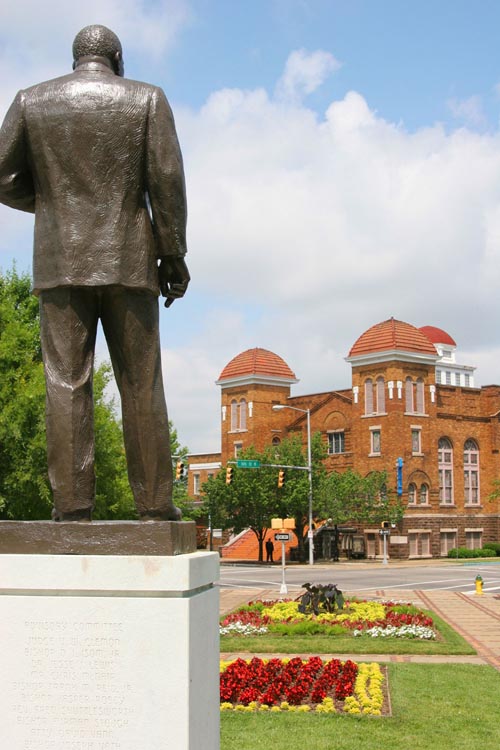Reunions were practically invented in the South. They allow us to reaffirm the significance of who we've known and what we've done, and to celebrate with joy our coming together again. Nowhere is this more evident than in Birmingham, where history and the legacy of the African-American struggle for equality greets you at every bend in the road. What better place for families to come together, and for young and old alike to retrace the steps of those upon whose shoulders we stand? As most people of a certain age remember, the second American Revolution took place in the streets of Birmingham. The city was a battlefield for
America’s Civil Rights Movement, a struggle for simple decency and common sense.
Though the
16th Street Baptist Church is the most famous civil rights landmark, it was
Birmingham’s Bethel Baptist Church that is credited with shaping the Civil Rights Movement here. Civil rights legend, the
Rev. Fred Shuttlesworth, was pastor of Bethel Baptist from 1953 through 1961. The church often served as a gathering place for civil rights discussions. Bethel was bombed by angry white supremacists first in 1958 while the church was unoccupied. The bombing cemented Shuttlesworth’s fiery determination to bring Birmingham to the center of the Civil Rights Movement. On Christmas night in 1956, another bomb exploded under the church parsonage where Shuttlesworth and his family were asleep. It is a miracle that the family walked away unharmed from their destroyed home. Shuttlesworth remained a central figure in the movement even after he moved to Cincinnati in 1961.
With the opening of the
Birmingham Civil Rights Institute in 1992, the city found a place to tell its own story. The institute documents the rise of the movement and the succession of events it bore around the nation: the 1955 arrest of Rosa Parks on a Montgomery bus for her refusal to give up her seat to a white man; the U.S. Supreme Court’s bus desegregation ruling in 1956; James Meredith’s 1962 admission to the Univ

ersity of Mississippi. www.bcri.org. Across the street from the Civil Rights Institute, the 16th Baptist Church was recently designated a National Historic Landmark. In the basement of the church on a September Sunday morning in 1963, four African-American schoolgirls were changing into their choir robes. A bomb set by Ku Klux Klansmen ripped through that side of the church, killing 11-year-old Denise McNair, along with Carole Robertson, Cynthia Wesley and Addie Mae Collins, all 14 years old.
The church bombing shocked and sickened the city and the world and was a turning point in the status of race relations thereafter. (The story of the 16th Street Church bombing is told with intensity in filmmaker Spike Lee’s documentary Four Little Girls.) Facing the Civil Rights Institute,
Kelly Ingram Park was a regular congregation area for organizing demonstrations in the early 1960s, including the ones in which police dogs and fire hoses were turned on the marchers by Birmingham police. Images of those attacks still haunt Birmingham, but they are the same images that were instrumental in overturning legal segregation.
The
4th Avenue Business District, also a part of the Civil Rights District, remains alive with restaurants, barbershops and bakeries. This cluster of black-owned businesses was the core of African-American social and commercial life in the early 1900s and later when white-owned shops and stores refused to serve black customers. Many minority-owned businesses still operate in the 4th Avenue District today, serving a steady stream of customers of all races. Down 4th Avenue North at 18th Street is the
Eddie Kendrick Memorial Park, a tribute to Birmingham native and
Temptations lead singer
Eddie Kendrick, who traveled the world but never forgot his Alabama roots. Sculpted by Birmingham artist
Ronald Scott McDowell, the Kendrick statue captures for eternity the magic moves of his Motown music. Inlaid in a granite backdrop behind Kendrick, the four other Temptations energize the work with their fine-tuned choreography.
The
Alabama Jazz Hall of Fame is only about a block down the street. If you’re lucky, jazz musician and historian Dr. Frank Adams will be on site and might even blow a tune on his clarinet.
www.jazzhall.com. Though located outside the district, another must-see Civil Rights gallery is
Chris McNair Studios and Art Gallery. The gallery features historic photos from the Civil Rights Movement by photographer
Chris McNair, father of one of the girls killed in the Sixteenth Street Church bombing. Also on site there is a room devoted to the young life of Denise McNair.
www.mcnairstudios.com